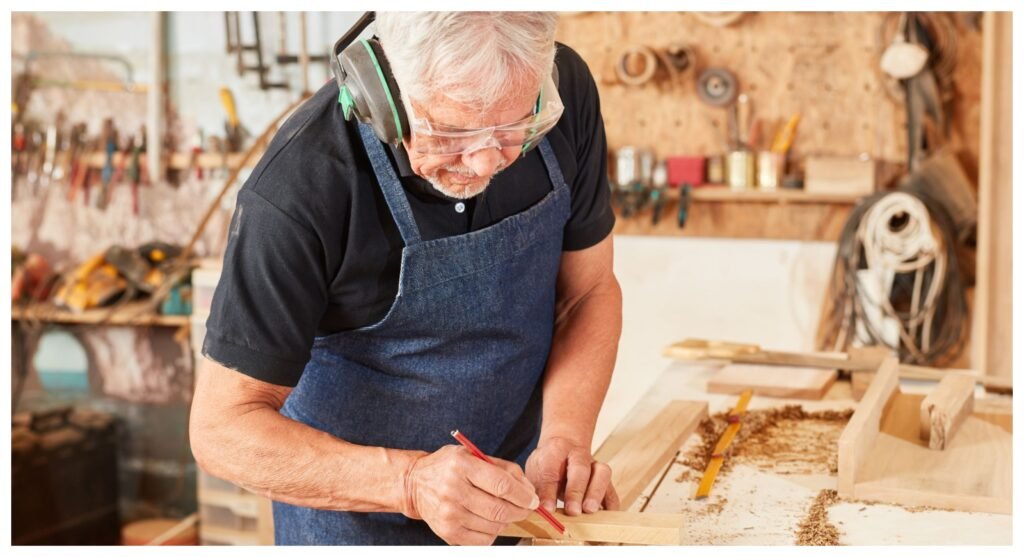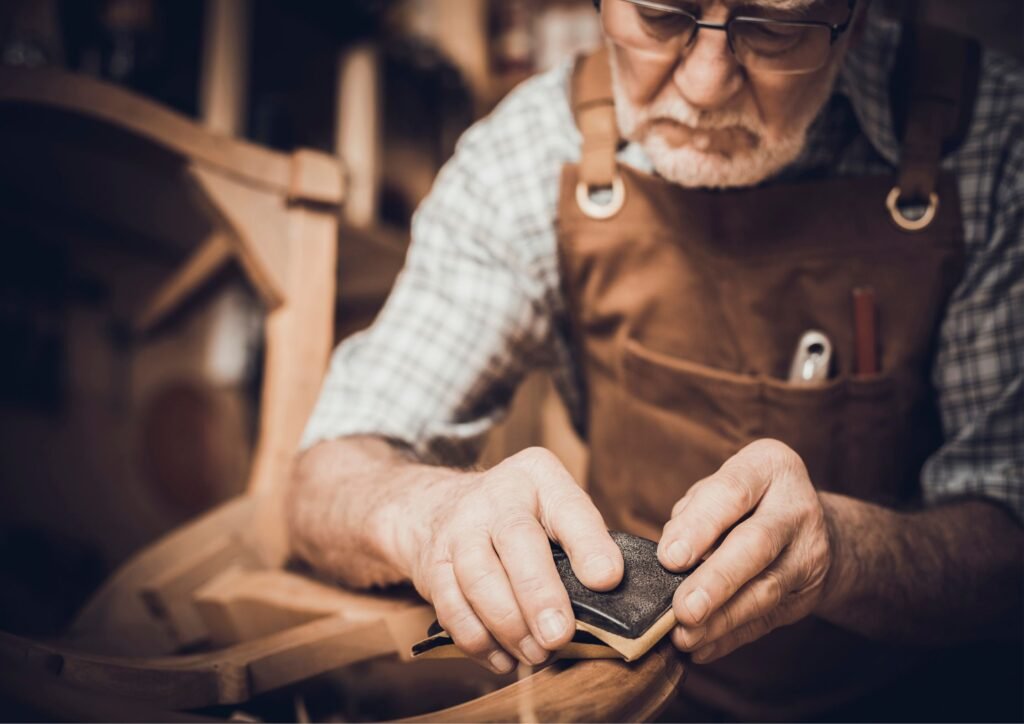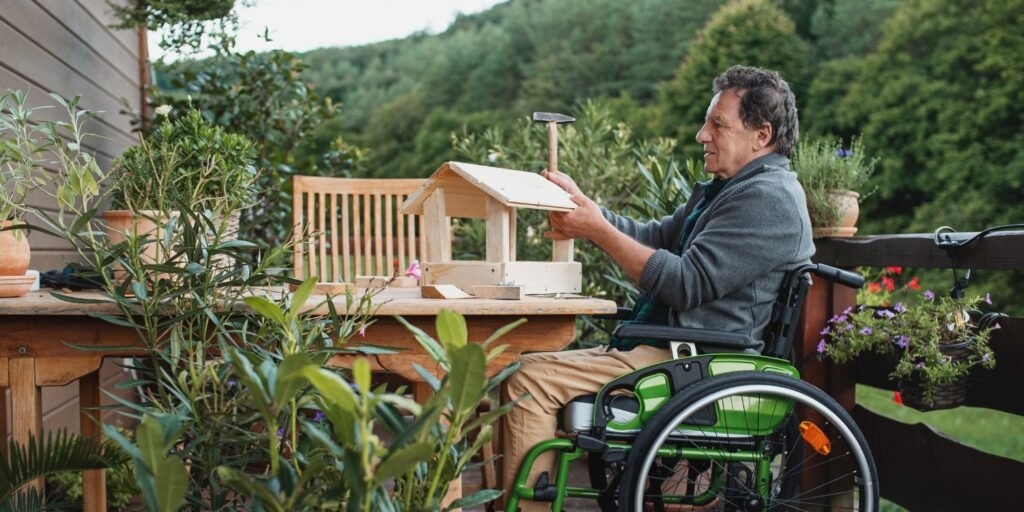The Joy of Woodworking for Seniors – From Sawdust to Satisfaction

Last Updated on June 27, 2025 by Julian Espinosa
Have you ever wondered what it would feel like to transform a simple piece of wood into something beautiful and functional with your own hands? Woodworking offers one of the most rewarding experiences for people entering their retirement years – combining creativity, physical activity, and mental stimulation in ways that can genuinely enhance your quality of life.
Recent research confirms what many woodworkers have known for years: this timeless craft provides remarkable benefits for both body and mind. Not only does woodworking strengthen hand-eye coordination and fine motor skills, but it also serves as a powerful cognitive exercise that can help maintain sharp mental function as you age.
The planning, measuring, and problem-solving involved in each project create what experts call a “whole-brain activity” that keeps neurological pathways functioning efficiently. Beyond the health benefits, woodworking offers a unique sense of accomplishment that’s hard to find elsewhere.
There’s something deeply satisfying about creating functional items – whether it’s a simple cutting board for your kitchen or an elegant jewelry box for a grandchild – that will be treasured for generations. The craft also provides an excellent opportunity for social connection, whether you’re sharing techniques with fellow woodworkers or teaching skills to family members.
Whether you’re a complete beginner or someone looking to rekindle an interest from years past, woodworking can be adapted to suit any skill level or physical ability. With the right approach, proper safety measures, and adaptive tools when needed, this fulfilling hobby can become a cornerstone of your active retirement lifestyle.
Ready to discover how woodworking can enrich your retirement years? Let’s explore everything you need to know to get started.
Why Should You Consider Woodworking for Seniors?
Woodworking has recently experienced a resurgence in popularity due to its longstanding tradition as a beloved pastime and the growing trend of DIY projects. Remarkably, even older individuals have discovered newfound satisfaction in woodworking, indicating that it’s not solely reserved for the younger generation.
Seniors who engage in it may experience a sense of achievement while crafting furniture, home decor, or other wooden items. However, some seniors may hesitate to begin woodworking for seniors due to their physical limitations or lack of familiarity with woodworking tools.

Prefer to listen rather than read?
Benefits of Woodworking for Seniors
Woodworking for seniors is a fantastic activity that offers seniors a world of benefits beyond just crafting stunning and practical pieces. Get ready to experience the joys of working with wood, as you explore the endless possibilities of this amazing hobby!
Here are 5 Reasons Why Woodworking is Great for Seniors:
- Promotes Physical Activity and Dexterity
- Woodworking for seniors requires physical activity and dexterity, which helps maintain muscle strength and hand-eye coordination. Seniors can stay active and improve their motor skills while working on these tasks, minimizing age-related decline.
- Improves Cognitive Function
- It can aid in enhancing cognitive function for seniors by improving their problem-solving skills, memory, and attention span. Engaging in problem-solving tasks challenges the brain and helps seniors keep their minds active and sharp.
- Provides a Sense of Accomplishment
- It is a satisfying and pleasurable hobby for seniors that fosters a feeling of accomplishment and pride in the final creation. Older adults can create exquisite and practical items that they may use or exhibit in their residences, resulting in a sense of gratification and contentment.
- Fosters Socialization
- It provides an opportunity to connct with others who share a similar interest and promotes a sense of companionship. Seniors can participate in woodworking organizations or attend workshops to expand their social circle and discuss their enthusiasm for woodworking.
- Overall Health Benefits
- Woodworking for seniors is an ideal activity for seniors seeking to remain active and engaged. Engaging in wooden projects can promote overall well-being by mitigating stress and elevating mood, offering numerous physical and mental health benefits.
Getting Started: Your First Workshop Setup
You don’t need an elaborate workshop to begin woodworking. Many successful projects can be completed with basic hand tools and a small workspace. Start with essential tools like a tape measure, pencil, handsaw, chisel set, sandpaper, and wood glue. As your interest grows, you can gradually add power tools and expand your workspace.
Safety should always be your top priority. Invest in quality safety equipment including safety glasses, hearing protection, and dust masks. Good lighting is crucial for both safety and precision. If you have concerns about using traditional tools, there are adaptive woodworking tools for seniors. These include tools with larger, ergonomic handles for easier grip, low-vibration power tools, and workbenches at comfortable heights.
Consider starting with a class at a local community center or woodworking club. Many areas have woodworking groups specifically for retirees, providing both instruction and social interaction. These communities often have well-equipped workshops you can use before investing in your own tools.
Tools and Materials Needed
Woodworking for seniors is a satisfying and pleasant activity for seniors that can bring immense gratification. Before commencing, it’s crucial to possess the requisite tools and materials. Check out these 5 essential tools and materials for seniors to start woodworking:
Basic Tools
The necessary tools for a project vary depending on its nature, but certain essential tools are crucial. These tools include a saw, drill, hammer, and sandpaper, which facilitate wood cutting, drilling, nailing, and sanding. Here are some essential tools for woodworking:
Different types of saws are utilized as cutting tools.
- Hand saws are ideal for precision cuts, especially on small projects.
- Circular saws are best for larger projects and straight cuts, especially for plywood or MDF.
- Jigsaws are perfect for intricate cuts and curves, but they may not be as precise as other saws.
- Band saws are useful for resawing, cutting curves, and creating intricate designs.
Drills are a critical tool required in woodworking.
- Cordless drills are versatile and easy to use, making them perfect for most woodworking projects.
- Impact drivers are excellent for driving screws and other fasteners quickly and efficiently.
- A drill press is great for creating precise holes at different angles, especially when you’re working with larger pieces of wood.
Various hammers serve distinct functions.
- Claw hammers are versatile tools that are commonly used in woodworking for a range of projects.
- Framing hammers are optimal for weightier endeavours, like constructing a deck or framing a dwelling.
- Sledgehammers are perfect for demolishing large structures or breaking up concrete.
Sanding tools are essential for achieving a polished woodworking finish.
- Sanding blocks are great for small projects and they provide better control and precision than power sanders.
- Random orbit sanders are versatile and can handle most sanding tasks, including rough and fine sanding.
- Belt sanders are best suited for extensive, level areas, although they may prove too forceful for certain tasks.
Having the appropriate skills and tools is both essential in achieving the desired woodworking outcome. The calibre of tools used in woodworking for seniors is crucial in determining project success. Using high-quality and durable tools guarantees woodworkers can work with confidence and efficiency, avoiding harm to the material or themselves.
To effectively practice woodworking for seniors, one must utilize chisels, hand planes, jigs, clamps, and measuring devices, in addition to saws, drills, and sanders.

Workbench or Table
A robust work surface is crucial for any woodworking project. A proper workbench or table offers a stable foundation for precise cuts and measurements. In the absence of a sturdy and dependable work surface, woodworking projects can swiftly become hazardous and exasperating.
When choosing a workbench or table for woodworking for seniors, it’s crucial to consider the appropriate size and weight capacity to meet your requirements. Larger projects may necessitate a bigger work surface, while beginners or those with limited space might benefit from a smaller one.
Moreover, it’s essential to make sure the work surface is level and flat, as even slight irregularities can negatively impact the precision of your cuts and measurements. Ultimately, investing in a top-quality work surface is a vital component in producing woodworking projects that are both successful and safe.
Safety Equipment
Prioritizing safety measures is crucial when using power tools to prevent accidents and serious injuries in woodworking for seniors. Wearing suitable safety gear, such as safety glasses and ear protectors, is a fundamental precaution.
Safety glasses are specifically designed to shield the eyes from flying debris, sparks, or dust when operating power tools. They should be made from high-quality materials that can endure impact and fit securely to prevent any foreign objects from entering the eye area.
Using ear protectors can lower the chance of hearing damage resulting from the amplified decibels generated by machinery. It’s also crucial to guarantee secure work environments by operating such tools in well-lit and well-ventilated spaces. Before using a power tool, comprehending the user manual is crucial to ensure appropriate usage and prevent accidents arising from incorrect tool usage.
It’s equally imperative to conduct regular inspections and maintenance of the tool to ensure optimal functionality, which includes replacing worn-out parts, lubrication, and identifying any damage. By adhering to these safety precautions, the risk of accidents and injuries when operating power tools can be significantly reduced.
Wood Materials
The kind of wood is the primary consideration in woodworking. Each variety of wood possesses unique characteristics, attributes, and benefits, and selecting the appropriate one for your project can be a decisive factor. For example, Pine is a popular choice among novice woodworkers due to its cost-effectiveness and versatility. Its proficiency in accepting stains and easy handling make it an ideal option for various projects.
On the contrary, Oak is a sturdier alternative commonly used in furniture production. Its robustness, exquisite appearance, and resilience against damage make it a desirable choice. Cherry is also a widely favoured option, distinguished for its warm, reddish-brown hue, and refined texture. It’s a popular selection for luxurious furniture and cabinetry due to its natural elegance and durability.
Irrespective of your preference, it’s essential to select a high-grade wood that’s devoid of imperfections and crevices to guarantee the triumph of your undertaking.
Adhesives and Fasteners
Selecting the appropriate adhesives and fasteners is imperative in woodworking to guarantee the durability and sturdiness of the finished product. Wood glue is a prevalent adhesive used to secure wooden pieces and establish a robust bond. Nonetheless, it’s crucial to determine the most suitable adhesive for the specific project.
Considering that diverse adhesives possess distinct characteristics and strengths. Some adhesives are ideal for outdoor applications because of their waterproof properties, while others are more appropriate for indoor projects. Nails and screws are frequently utilized to join pieces of wood together, in addition to adhesives.
Lighter-duty applications typically make use of nails, whereas screws are more suitable for heavier-duty projects, providing a stronger hold. To guarantee a secure hold, it’s crucial to select the proper size and type of nail or screw for your project. Pre-drilling holes can aid in preventing the wood from splitting or cracking when using screws.
Choosing the appropriate adhesives and fasteners for your project will result in a strong and long-lasting finished product.
Safety Tips for Seniors
Woodworking for seniors is a stimulating and artistic activity for seniors. However, it poses safety hazards, particularly when handling sharp tools and equipment.
Seniors must take necessary precautions to avoid accidents and injuries. Presented below are three essential safety tips for seniors engaged in woodworking:
Wear Protective Gear
Protective gear is crucial for ensuring workplace safety, especially in woodworking for seniors. Personal Protective Equipment (PPE) like safety glasses, gloves, and ear protection significantly lower the chance of accidents and injuries when operating power tools.
PPE functions as a barrier between the worker and the tool or material, shielding them from hazards like flying debris, electrical shock, and loud noises.

Emphasizing the importance of wearing protective gear while working with power tools is crucial. Failing to wear proper personal protective equipment (PPE) or making even a brief lapse in judgment can result in grave and sometimes irreversible injuries.
Adhering to all safety protocols, including utilizing protective gear, to prevent accidents and uphold a secure work environment.
Implementing these measures will enable senior to steer clear of potential hazards and ensure their work environment remains safe.
Keep the Work Area Clean and Organized
Safety should always be a paramount concern in the workplace. A cluttered workspace not only appears unprofessional but also poses significant hazards to you. Disorganization can result in slips, trips, and falls, which carry the potential for severe injuries.
A cluttered workspace can hinder the safe use of power tools and sharp objects, further heightening the risk of accidents and injuries. To reduce hazards, it’s essential to maintain a neat, organized workspace.
This involves regularly tidying up and arranging the work area, storing equipment and supplies in designated locations, and implementing a thorough cleaning routine.
Establishing a secure and organized work environment can prevent mishaps and harm, while also boosting productivity and effectiveness. It’s vital to comprehend that sustaining a tidy and orderly workspace is not solely a matter of aesthetics, but a fundamental element of workplace welfare and prosperity.
Take Breaks and Stay Hydrated
Seniors should be aware of their physical constraints and take regular breaks to rest and stretch during woodworking activities. Woodworking for seniors can place significant physical strain, hence it’s crucial to stay hydrated to avoid exhaustion and lightheadedness. By following these safety tips, seniors can safely and confidently engage in the joy of woodworking.
It’s essential to find a project that fits one’s interests and capabilities to maximize the enjoyment of the experience. There’s no shortage of woodworking ideas, ranging from small home decor items to large furniture pieces. For seniors, selecting an appropriate project is vital.
Progressing from simple to complex endeavours can enhance skills and bolster confidence. Adequate time and resources must also be considered.
Obtaining the necessary tools and materials and dedicating ample time to the task can lead to a satisfying and successful outcome. With tenacity and practice, the myriad of possibilities in woodworking for seniors is boundless.
Step-By-Step Instructions for Completing a Project
The practice of woodworking for seniors presents a promising avenue for seniors seeking to derive a sense of gratification from their creative pursuits. However, it may pose a considerable challenge for those who lack prior experience in this craft.
Proper tutelage, however, transforms the activity into a gratifying and engaging experience. Presented below are five systematic guidelines to successfully execute a woodworking project.
Choose a Project
Woodworking for seniors is a gratifying pursuit that empowers them to craft both aesthetically pleasing and serviceable items from raw materials. For novice woodworkers, selecting a suitable project can be daunting. Nevertheless, it’s imperative to pick a venture that aligns with one’s skill level and interests. For example, a beginner should embark on a simple project like building a birdhouse or a step stool.
Such undertakings necessitate rudimentary tools and techniques and can be accomplished with dispatch. When choosing a woodworking project, it’s important to consider your skill level and available tools. Opt for a project that matches your abilities to ensure success and avoid frustration. Also, take into account your interests.
Do you prefer working with a specific type of wood or creating furniture with a particular style? Selecting a project that aligns with your interests will increase motivation and result in a satisfactory outcome. As you gain experience, challenge yourself with more complicated projects to improve your woodworking skills.
Gather the Materials
Gathering the appropriate materials and tools is a critical factor for success in the realm of woodworking for seniors. Careful consideration must be given to the essential components required for any project. Adequate time must be allocated to the procurement of these materials, a necessary step before embarking on any woodworking venture.
This includes the selection of appropriate wood species, ranging from oak to maple, to pine, as well as the indispensable screws, nails, and fasteners necessary for proper assembly. Possession of appropriate cutting tools, including saws for shaping the wood to desired dimensions, hammers for affixing fixtures, and drills for creating perforations and attaching hardware, is essential.
Read the Plans
A fundamental component of woodworking for seniors is adhering to instructions and plans. To guarantee triumph, it’s critical to meticulously peruse the instructions and comprehend the involved procedures. Doing so can impede the occurrence of fatal blunders or inaccuracies that may compromise the entire project.

Visualizing each step helps to ensure a clear understanding of the task at hand, aiding in organization and progress tracking. Proper visualization also enables the identification and resolution of potential issues before they cause problems.
While reading and understanding instructions may seem time-consuming, it ultimately saves time and frustration by preventing mistakes and guaranteeing success.
Take Your Time
Achieving desired results in woodworking for seniors demands patience and meticulousness. Hastening through a project may result in expensive and time-consuming corrections. Devoting sufficient time to meticulous planning and execution of each step can alleviate frustration and save time in the long term.
Precision is paramount in woodworking for seniors, as even minor mistakes can jeopardize both the physical stability and visual allure of a completed project. Diligent measurement and marking of cuts, thorough sanding, and careful test-fitting of components before final assembly are essential steps that enable woodworkers to achieve optimal accuracy in their craft.
Finishing Touches for a Successful Project
Woodworking for seniors is a gratifying activity for seniors that can produce admirable, handcrafted items. Nonetheless, the final stages of a woodworking project are critical for the success of the final product. Initial sanding of the piece is imperative to avoid any coarse or jagged edges that may cause harm to anyone handling it.
It’s recommended to employ fine-grit sandpaper for a flawless finish. Before applying the finish, it’s imperative to thoroughly clean the piece and eliminate any dust or debris. Employing a tack cloth or soft rag can assist in eliminating any lingering particles. Subsequently, apply the appropriate finish based on the type of wood in use. It may be necessary to apply a sealer before staining certain types of wood.
After completing the project, ensure that it is left to dry and cure as directed by the finish instructions. This will not only guarantee a successful outcome but also a secure and durable woodworking item for seniors to display or use with pride.
Enjoy the Finished Product
Upon finishing a project, it’s crucial to reflect on your accomplishments and recognize the hard work invested. You have diligently brought your concept to fruition, surmounting obstacles in the process. It’s vital to take pride in your achievement and commemorate your success.
Take pride in your project and utilize it as a chance for learning. Assess both the successes and areas for improvement. Recognize the skills and knowledge acquired during the project, and contemplate how they can be applied to future endeavours.
Reflecting upon and learning from your experience will enhance your professional growth and development in the field of woodworking for seniors. Keep in mind that each project serves as a building block for future accomplishments.
Tips for Maintaining Tools
To maximize the lifespan and performance of woodworking tools, proper maintenance is crucial. Ensuring they are in optimal condition not only enhances their durability but also makes your projects safer and more enjoyable. Here are some tips for maintaining your woodworking tools:
- Maintain the tool’s cleanliness. After usage, cleanse your tools with a cloth to eliminate dust and debris. This will avert accumulation that might lead to corrosion or other harm.
- Sharpen regularly. Sharp tools are safer and easier to use. Keep blades sharp by using a sharpening stone or other sharpening tools regularly.
- Lubricate moving parts. Proper lubrication of mobile parts such as hinges and bearings is essential to prevent rust and decay.
- Store tools properly. Store your tools in a dry and secure place, preferably in a toolbox or cabinet.
- Check for wear and tear. Regularly inspect your tools for indications of wear and tear, like blades that are chipped or handles that are cracked. Subsequently, replace any tools that have been damaged as required.

Overcoming Common Concerns
Many people hesitate to start woodworking because they worry about physical limitations or lack of experience. The good news is that woodworking can be adapted to accommodate various physical abilities and skill levels.
If you have concerns about grip strength or hand mobility, adaptive tools and techniques can help. Ergonomic handles, lightweight tools, and adjustable workbenches can make woodworking accessible for almost everyone. Many woodworkers find that the activity actually helps improve their hand strength and dexterity over time.
Don’t let the learning curve discourage you. Modern woodworking resources, including online tutorials, books, and local classes, make it easier than ever to learn proper techniques. Start with simple projects and gradually build your skills and confidence.
Building Community Through Woodworking
One of the unexpected joys of woodworking is the community it creates. Woodworkers are generally generous with their knowledge and eager to help newcomers learn. Local woodworking clubs, maker spaces, and community workshops provide opportunities to meet like-minded people and share your passion for the craft.
Many woodworkers find purpose in creating items for charity or teaching skills to younger generations. This gives your hobby additional meaning and helps you stay connected to your community in meaningful ways.
Making Woodworking Sustainable and Enjoyable
As you develop your woodworking skills, consider the environmental impact of your hobby. Choose sustainably sourced wood when possible, and look for ways to repurpose or recycle materials. Many woodworkers find satisfaction in giving new life to reclaimed wood or furniture pieces.
Keep your projects varied to maintain interest. Alternate between practical items for your home and gifts for family and friends. This variety keeps the hobby fresh and provides natural motivation to continue learning new techniques.
Set up your workspace for comfort and efficiency. Good organization, proper lighting, and comfortable seating can make your woodworking sessions more enjoyable and productive.
Conclusion
Woodworking for seniors is a worthwhile and pleasurable hobby for them, offering cognitive benefits, stress relief, and a sense of fulfilment. Seniors can conveniently acquire new skills and techniques by attending workshops and classes, or by accessing online resources. Engaging in woodworking for seniors allows them to exercise their creativity and craft their own unique creations.
This timeless pursuit can bring joy and satisfaction to seniors as they continue to work with their hands and create something one-of-a-kind. Would you love to start your woodworking for seniors journey now?
Frequently Asked Questions About Woodworking for Seniors
- Is woodworking safe for seniors with arthritis or limited hand strength?
- Absolutely! Many woodworkers with arthritis continue to enjoy their craft by using adaptive tools with ergonomic handles, lightweight equipment, and proper workspace setup. The gentle, repetitive motions of woodworking can actually help maintain hand flexibility and strength.
- How much space do I need to start woodworking?
- You can begin woodworking in a space as small as a garage corner or spare room. Many projects can be completed with portable tools and a folding workbench. As your interest grows, you can expand your workspace accordingly.
- What’s the best way to learn woodworking as a beginner?
- Start with a basic class at a community center or woodworking club. These provide hands-on instruction, safety training, and access to tools before you invest in your own. Online tutorials and books can supplement your learning.
- How expensive is it to get started in woodworking?
- You can begin with basic hand tools for under $200. Start with essential items like a saw, chisels, measuring tools, and sandpaper. Build your tool collection gradually as you discover which types of projects you enjoy most.
- Are there woodworking communities specifically for seniors?
- Yes! Many areas have woodworking clubs that cater to retirees. Community centers, senior centers, and maker spaces often offer woodworking programs. These groups provide both instruction and social interaction.
- What types of projects are best for beginners?
- Start with simple, functional items like cutting boards, plant stands, or picture frames. These projects teach basic skills without being overwhelming. As you gain confidence, progress to more complex pieces.
- Can I do woodworking if I live in an apartment?
- While challenging, apartment woodworking is possible with hand tools and portable equipment. Focus on smaller projects and consider using shared workshop spaces or community maker spaces for larger projects.
- How do I know if the wood I’m buying is good quality?
- Look for wood that’s straight, dry, and free from major defects. Start with common woods like pine, oak, or maple from reputable suppliers. As you gain experience, you’ll develop an eye for selecting quality materials.






Responses